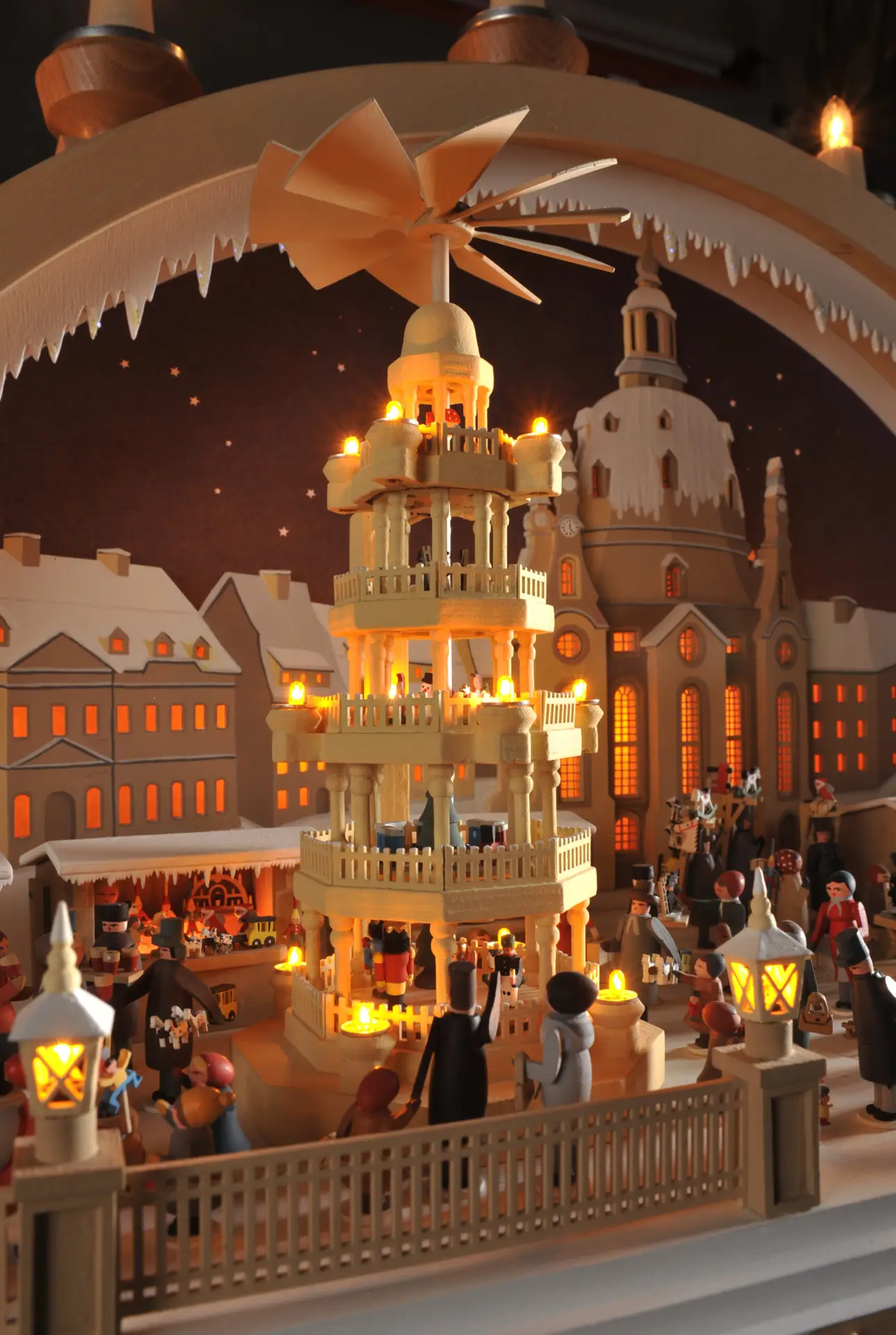Dresden and its connection to the Ore Mountains
Dresden has a direct connection to the Ore Mountains – not only as the state capital, but also for historical reasons.
In 1809, the four toy makers Johanna Christiane Schneider, Gotthelf Friedrich Fichtner, Christian Friedrich Kämpe and Samuel Gottlieb Neubert received permission to to sell their goods directly at the foot of the Frauenkirche. This was an important step, as it enabled them to bypass the middleman, who cost them a large part of their income at the time. It is therefore particularly important to us to commemorate this historic event.
The current appearance of Dresden with its magnificent baroque buildings was also largely financed by the considerable funds that flowed into the state treasury from the silver mining in the Ore Mountains.
The reconstruction of the Frauenkirche after its destruction in 1945 was an important step against forgetting. Dresden is therefore not only a contemporary witness of the past, but also an important monument of the present. For this reason, the motif of the Frauenkirche with the Striezelmarkt is an integral part of our range.
The trigger for the production of a candle arch with the motif of the Frauenkirche with the Striezelmarkt was the reconstruction of the Frauenkirche and the four Seiffen toy makers “Johanna Christiane Schneider”, “Gotthelf Friedrich Fichtner”, “Christian Friedrich Kämpe” and “Samuel Gottlieb Neubert”, who were allowed to sell their goods at the foot of the Frauenkirche for one sunny day in 1809 in order to alleviate their social hardship. Because I feel connected to these four toy manufacturers, I developed a whole series of arches with this motif, the proceeds of which the Klaus Kolbe manufactory donated a sum to the reconstruction of the Frauenkirche and received the golden letter of donation for this. In 2003, the first limited edition of the mechanical candle arch “Dresden Striezelmarkt” was created. The limited edition of 1000 pieces was sold out within 3 years. The unbroken interest and the ongoing demand prompted me to reissue this motif in a completely different form.

With this candle arch, limited to 1000 pieces, I wanted to create a “living painting” to commemorate the respected painter and graphic artist, my friend Max Christoph (22.02.1918 – 22.01.2013) from Dörnthal. I would like to dedicate this work of art to him with deep respect and gratitude.
This 2nd edition is a depiction of the Dresden Striezelmarkt between past and present. It shows an illuminated pyramid, detailed street lamps, and a portrait of Ludwig Richter “sold out due to business closure”.
The illuminated, mechanically movable base shows in detail the creation of the porcelain by Johann Friedrich Böttger (1682-1719) and Ehrenfried Walther von Tschirnhaus (1651-1708), right down to the painting. During his training as a pharmacist, Böttger’s interest in alchemy was awakened.
He later boasted of being able to transform base metals into precious ones, which brought him to the attention of Augustus the Strong. Böttger was captured to produce gold for the Elector of Saxony so that he could fill his state coffers. He was initially given a laboratory in the Fürstenberg House in Dresden. There, the naturalist Tschirnhaus took over closer supervision of Böttger. Together they then researched ceramics and finally managed in 1708 to produce the base material for porcelain from 2 parts kaolin (white earth), which was mined in Aue and Schneeberg, 1 part quartz and 1 part potassium feldspar. The valuable raw material kaolin was transported to Dresden in safe carriages, which were usually used to transport silver bars, in absolute secrecy with escorts. Tschirnhaus died as a result of the experiments and Böttger then headed the Meissen porcelain factory, which was founded in 1710. In 1714 he was released from his 12-year imprisonment and died in 1719 at the age of just 37 from the effects of his research work, which involved substances that were in part toxic. We owe one of Saxony’s most important inventions to Tschirnhaus and Böttger: European porcelain.
The musical mechanism, on which the original bells of the Dresden Frauenkirche can be heard, was made in Switzerland directly for this candle arch and exclusively for our factory and is therefore unique.
Special thanks go to my employees and my family, who supported me actively and consistently in the development of this work of art. I wish you lots of joy and all the best as you delve into the history of the invention of porcelain and look at the Christmas ensemble at the Striezelmarkt.
Klaus Kolbe, Seiffen 28.02.2013


Manufaktur Klaus Kolbe GmbH
Steinhübel 31
09548 Kurort Seiffen
© Copyright 2025 Manufaktur Klaus Kolbe | All Rights Reserved. | realisiert mit d3sign.me
To provide you with the best possible experience, we use technologies such as cookies to store and/or access device information. If you consent to these technologies, we may process data such as browsing behavior or unique IDs on this website. If you do not give or withdraw your consent, certain features and functionality may be affected.